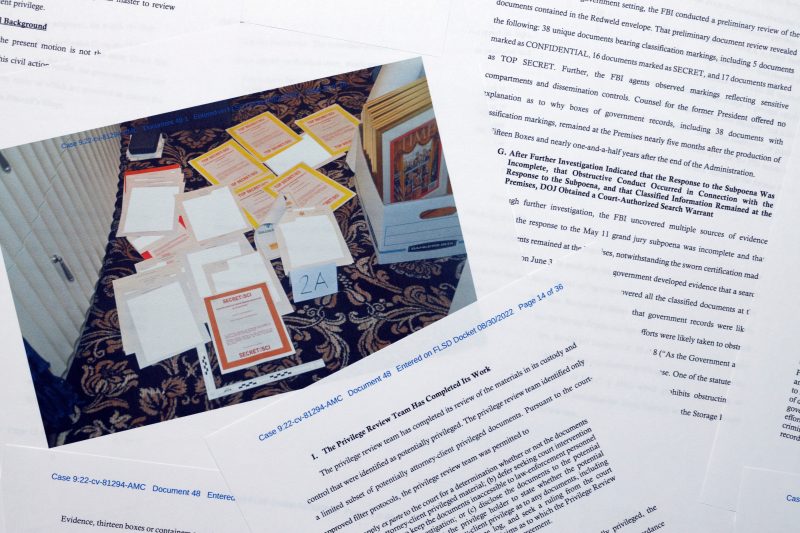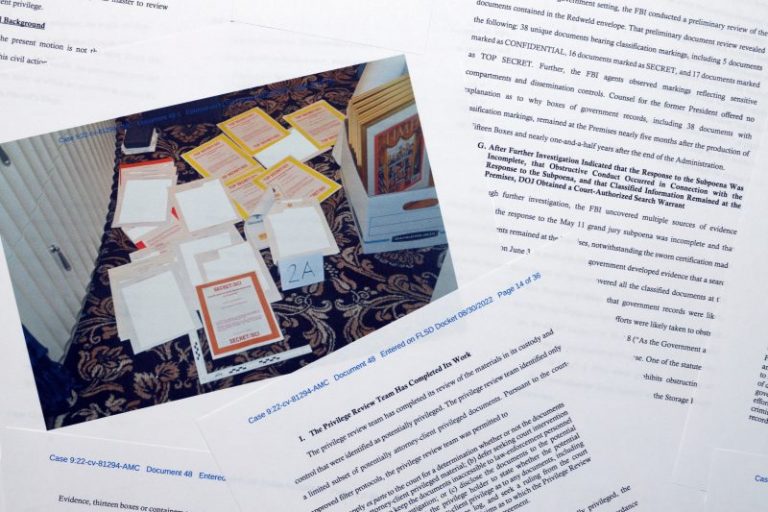
The most famous photo from the FBI’s search of Mar-a-Lago last year shows an array of documents spread on the floral carpet of a room at the facility. Some of what’s shown includes cover sheets for classified material, indicating that the attached documents have been determined to be “secret” or “top secret.” Other documents, some obscured with white boxes by the Justice Department, have visible classification identifiers at the top of standard sheets of paper.
This is the photo that former president Donald Trump would subsequently suggest had been staged by the FBI to make it look like it had stumbled onto an orgy of classified material lazily thrown on the floor. The context of the photo makes obvious that’s not the case, though, with the inclusion of a photo scale and a small folded card labeled “2A.” The photo was meant not to impugn Trump directly but only indirectly, as evidence.
What’s important in the wake of a revealing interview of Trump on Monday by Fox News’s Bret Baier, though, is that folded card.
The “2A” identifier corresponds to the government’s documentation of the evidence it collected at Mar-a-Lago during the search. In the manifest of what was seized, Item 2A is listed as “[v]arious classified/TS/SCI documents.” It is apparently a subset of Item 2, identified as a “[l]eather-bound box of documents.” That box and its contents were removed not from the storage room near the Mar-a-Lago pool but from Trump’s office, where he was in the habit of entertaining visitors.
So now we jump to what Trump told Baier.
The Fox News host walked through the indictment made public this month. He asked Trump directly: Why, given that the Justice Department had eventually obtained a subpoena for any material marked as classified, hadn’t Trump simply handed that material over?
“Because I had boxes,” Trump replied. “I want to go through the boxes and get all my personal things out. I don’t want to hand that over to [the National Archives and Records Administration (NARA)] yet. And I was very busy, as you’ve sort of seen.”
“But according to the indictment,” Baier pressed, “you then tell this aide to move [material] to other locations after telling your lawyers to say you’ve fully complied with the subpoena when you hadn’t.”
“But before I send boxes over, I have to take all of my things out,” Trump said. “These boxes were interspersed with all sorts of things, golf shirts, clothing, pants, shoes. There were many things.”
This, too, is indexed in the list of material provided by the government: boxes that included both classified material and news articles, or items of clothing, or gifts. What the FBI removed from the storage room was a mix of all sorts of stuff — itself potentially damning when considering how material identified as classified was handled.
But none of this applies to Item 2, that box. It isn’t identified as “a box with some shirts and a few documents.” It’s just a box — a leather-bound one — sitting in Trump’s office, with documents. In that, it seems, were the documents that appear in that famous photo. Of the 15 documents originally identified by the FBI as bearing “top secret” classification, six were found in the Item 2A batch. Four were “TS/SCI,” which means they were classified as “top secret” and included “sensitive compartmented information,” a more restricted level of control.
They were in that box, in Trump’s office.
So how does this comport with Trump’s claim that he didn’t have time to rifle through those boxes and pick out his personal material? His criminal defense team will have to figure out a way to explain the gap, but the simple answer is that it doesn’t.
The defense is ludicrous, in general, of course. Trump had already worked his way through some of what he removed from the White House after he left, giving more than a dozen boxes to NARA in January 2022. The idea that over the next seven months he’d made no more progress defies credulity, particularly given numerous occasions during which he was engaged in any of his various leisure activities.
But Item 2A torpedoes the argument completely. He had these documents in that box in his office and unquestionably knew they were there. When the government subpoena arrived, that collection would have been trivial to flag for his lawyers to hand over (as they did some documents in June 2022). He chose not to.
So the question is why Trump made this claim to Baier. Here, again, the answer seems simple: He’s fighting a political fight, not a legal one.
As I wrote last week, assuming that Trump doesn’t agree to a plea deal, his best bet for escaping punishment for his retention of classified material is to win the presidency. This isn’t a sure thing, certainly, but it seems likely that he can win the Republican nomination and possible that he could defeat Joe Biden in November 2024. If that happens, Justice Department prohibitions on trying a sitting president kick in — and Trump gets to test the ability of a president to pardon himself.
It’s easy to overthink what Trump is up to, of course, because he is not known for his multidimensional strategies. Trump’s instinct here is the one that’s guided him in politics since he announced his candidacy eight years ago and in business well before that: Say what you need to say to close the deal with the audience.
He’s also learned that his core base of support, and those eager to leverage that base, don’t need a lot of explanation to side with him in his various fights against his perceived oppressors. So while his “I had to get my golf shirts out of those boxes” excuse is particularly weak as a criminal defense and completely useless when considering Item 2A, it may prove to be more than enough for any supporters who, like Baier, didn’t get why he didn’t simply respond to the subpoena. Oh, he was busy! Makes sense. This must just be the “Deep State” doing another hoax.
Trump did something similar when Baier asked about the recording, cited in the indictment, in which Trump told authors interviewing him in 2021 about a classified document he appeared to be brandishing.
Not so, Trump insisted.
“There was no document. That was a massive amount of papers and everything else talking about Iran and other things,” Trump said on Fox News. “And it may have been held up or may not, but that was not a document. I didn’t have a document per se. There was nothing to declassify. These were newspaper stories, magazine stories and articles.”
If this case goes to trial (which we have to assume that some on his legal team have been energetically recommending against that), there will at some point be a witness who attests to making that recording. One or more of the authors with whom Trump was speaking or staffers who were nearby will be asked, under oath, what Trump had at hand and what he appeared to be referring to. It’s a very, very safe bet that special counsel Jack Smith’s team already knows exactly what those witnesses might have to say and presumably have affidavits to that effect. In other words, the odds are very good that Trump’s “I was referring to news articles” line will hold up poorly when the government makes its case.
Trump undoubtedly knows what happened and certainly knows if he had a classified document in his possession at that time. It is very possible that he’s simply lying to Baier, trying to excuse away one of the most evocative, potentially incriminating aspects of the case.
If so, it’s a short-term win aimed at giving his allies something to say beyond, “Yeah, it looks bad.” Now the line goes forth: Trump was just talking about newspaper articles and Trump didn’t have time to go through all those boxes. It doesn’t even really matter if those excuses don’t hold up; the central viewpoint is that Trump is right and his oppressors are wrong and the facts are massaged or swapped out as needed to make that argument most effectively in the moment.
Again, this is a political-slash-rhetorical approach, not a particularly robust legal one. Trump’s freedom, though, may depend on his political strength and not his lawyers’ ability to introduce reasonable doubt in a courtroom.
In other words, all of the completely justified astonishment at Trump’s eternal willingness to implicate himself may be missing the point. He doesn’t need to win in front of a jury if he can win on Election Day. And voters don’t care about rules of evidence. Voters don’t make you swear under oath to the claims you’re making.
The election is the ideal venue for Trump to make his case.


Comments are closed.